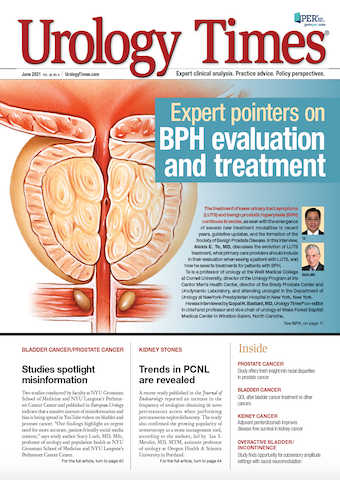Publication
Article
Urology Times Journal
The urologist’s role as a responsible opioid prescriber
Author(s):
Determine whether your prescribing habits are in line with your peers.
Robert A. Dowling, MD

Approximately 10.1 million Americans 12 years and older misused opioids in 2019.1 That same year, nearly 50,000 people in the United States died from opioid-involved overdoses.2 The CDC estimates that in 2019, more than 150 million opioid prescriptions were written at a rate of 46.7 prescriptions per 100 persons in this country.3 Although this number has declined from its peak 9 years ago, the opioid crisis remains a serious public health concern.
All but one state in the US (Missouri) have implemented prescription drug monitoring programs to help identify misuse by patients and reportedly improve outcomes and prevent deaths. In this article, I will focus on the urologist’s role as a responsible opioid prescriber in this crisis—and how you can determine whether your prescribing habits are in line with your peers.
Best Practices for Opioid Prescribing
The management of postoperative pain, the understanding of potential addiction, and the potential contribution by surgeons to long-term use of opioids has changed dramatically over the past 30 years. It has been estimated that 6% to 9% of urologic surgery patients show evidence of persistent opioid use 3 months after their surgery.4 In a study of 91,000 male patients in Canada undergoing minor urologic surgery (vasectomy, transurethral resection of the prostate, urethrotomy, hydrocelectomy, spermatocelectomy, and circumcision), Welk et al demonstrated that filling an opioid prescription was common (35%) and that although only 2% of those patients showed persistent use 9 to 15 months later, this represented a 43% increased odds of persistent use compared with patients who did not fill a prescription.5
Contemporary standards for use of opioids acknowledge the very real risk of persistent use. The American Urological Association (AUA) has issued a position statement on opioid prescribing6 that states in part: “Given increased accessibility of addictive opioids, the [AUA] strongly believes urologists have a responsibility to minimize their patients’ pain and also address serious risks of overprescribing opioids.…When opioids are necessary, [prescribe] the lowest dose and lowest potency to adequately control pain from surgery and other conditions [and discontinue] as soon as possible. Nonnarcotic methods of managing pain, including anti-inflammatories, acetaminophen, and nonmedication approaches, should be used when appropriate and adequate.…The [FDA] recommends all providers counsel patients and/or their caregivers about the safe use of opioids, serious risks, [and] proper storage and disposal with every prescription.”
Many resources are widely available to efficiently accomplish this patient counseling.7 Urologists prescribe opioids most frequently for acute pain, including postoperative discomfort, and should have no issue with these best practices outlined by public health officials and our own specialty society.
Opioids for chronic pain are outside the scope of most urologists, and those who do manage chronic opioid use should familiarize themselves with guidelines and requirements in their local jurisdiction. For example, in Texas, a physician treating chronic pain must develop a written treatment plan, obtain informed consent, and use a written pain management agreement between the physician and the patient outlining patient responsibilities.8
Examining Prescribing Habits in Urology
The Centers for Medicare & Medicaid Services (CMS) has released 2018 data on the opioid prescribing rates of providers in the Medicare Part D program. (You can view your individual data at https://data.cms.gov/d/j2ra-95gh/visualization.) Keep in mind, however, that Part D prescribing and dispensing habits may not be generalizable to all patients in a urology practice.
In 2018, 1.2 million providers submitted more than 69 million opioid claims in the Medicare Part D program at an average rate of 80 claims per provider. Opioid prescribing rate is measured as the percentage of opioid claims among all Part D claims, and it averages 9% for all specialties. The specialties with the highest opioid prescribing rates are hand surgeons (55%), podiatric assistants (54%), and pain management providers (50%). Urology ranks 64th among specialties in opioid prescribing rate. The specialties with the highest number of opioid claims per provider are pain management (1326), anesthesia (495), and physical medicine and rehabilitation (431); these 4 specialties account for 16% of all opioid claims in Part D in 2018 (Table 1).9

In the 2018 CMS opioid data set, 10,754 urologists identified as prescribers, with 7142 identified on an opioid claim. Collectively, urologists prescribed less than 1% of all opioids (417,700 claims) in Part D in 2018. The average opioid prescribing rate for all urologists was 4.9%, and for those with at least 1 opioid claim, it was 5.7%. The average number of opioid claims for urologists prescribing any opioid was 58. These metrics are well below the national average for all specialties. Only 43 urologists were identified with long-acting opioid claims in 2018.9
The opioid crisis has not affected all states evenly, and opioid dispensing rates/person vary widely across the US. The CDC publishes dispensing data by state and by county, and 11 states have rates over 64 per 100 persons.10 The average number of claims per urology provider ranked by state correlates generally with the dispensing data (high rates in the same states), and urologists do not appear to prescribe opioids evenly across the US (per provider) either. If we examine the entire Medicare Part D prescriber database for 2018, we can see the opioid drugs most commonly prescribed by urologists—hydrocodone/acetaminophen and oxycodone HCl/acetaminophen—collectively account for approximately 75% of all opioid prescriptions (Table 2).11

Bottom line: The Medicare Part D data demonstrate that urologists collectively prescribe opioids in numbers and rates lower than the national average of all specialties and unevenly across the US. Very few urologists are linked to claims for long-acting opioids. Urologists should be aware of the small but significant risk of opioid prescription that leads to persistent use or even abuse and follow specialty guidelines for counseling and prescribing. Medicare Part D data on each individual prescriber is readily available to urologists, patients, and the public.
References
1. Help and resources: national opioids crisis. US Department of Health and Human Services. Accessed April 5, 2021. https://bit.ly/3o5JfUB
2. Opioid overdose crisis. National Institute on Drug Abuse. March 11, 2021. Accessed April 5, 2021. https://bit.ly/2Q5zbhX
3. U.S. opioid dispensing rate maps. CDC. Updated December 7, 2020. Accessed April 5, 2021. https://bit.ly/3y1AJKT
4. Ziegelmann MJ, Findlay BL, Britton CJ, Habermann EB. Opioid prescribing after urologic surgery: we are part of the problem and part of the solution-an invited commentary on “an opioid prescription for men undergoing minor urologic surgery is associated with an increased risk of new persistent opioid use.” Transl Androl Urol. 2020;9(3):997-1000. doi:10.21037/tau-2020-05
5. Welk B, McClure JA, Clarke C, Vogt K, Campbell J. An opioid prescription for men undergoing minor urologic surgery is associated with an increased risk of new persistent opioid use. Eur Urol. 2020;77(1):68-75. doi:10.1016/j.eururo.2019.08.031
6. AUA position statement: opioid use. American Urological Association. August 2018. Updated January 2019. Accessed April 5, 2021. https://bit.ly/3uC3FHl
7. Prescription opioids: what you need to know. CDC. Accessed April 5, 2021. https://bit.ly/3o1XxFU
8. Texas administrative code. Texas Secretary of State. Updated July 13, 2020. https://texreg.sos.state.tx.us/public/readtac$ext.TacPage?sl=R&app=9&p_dir=&p_rloc=&p_tloc=&p_ploc=&pg=1&p_tac=&ti=22&pt=9&ch=170&rl=3
9. Medicare Part D opioid prescriber summary file 2018. Centers for Medicare & Medicaid Services (CMS). January 7, 2021. Accessed April 5, 2021. https://bit.ly/3bi7oCj
10. U.S. state opioid dispensing rates, 2018. CDC. Updated December 7, 2020. Accessed April 5, 2021. https://bit.ly/3vYm4OL
11. Part D prescriber data CY 2018. CMS. Updated December 3, 2020. Accessed April 5, 2021. https://go.cms.gov/2Qe6oHz

Newsletter
Stay current with the latest urology news and practice-changing insights — sign up now for the essential updates every urologist needs.






















